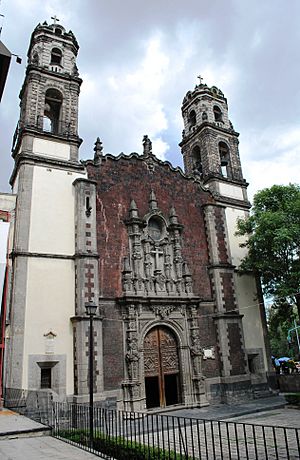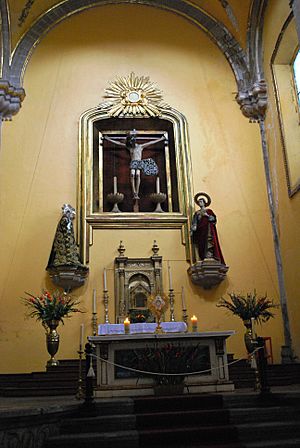Santa Veracruz Monastery, Mexico City facts for kids
Quick facts for kids Santa Veracruz Monastery |
|
|---|---|
 |
|
| Location | Mexico City |
| Country | Mexico |
| Denomination | Roman Catholic |
| History | |
| Founder(s) | Hernán Cortés |
The Santa Veracruz Monastery is a very old church in the historic center of Mexico City. In the 1500s, it was one of the three most important churches there. A special group called a brotherhood, started by Hernán Cortés, built it.
The first church was built in 1586. However, it was replaced in the 1700s by the building you see today. The old monastery and hospital parts are now the Franz Mayer Museum. But the church still works as a church. Many of its original decorations are gone. Still, it holds two important statues: the Christ of the Seven Veils and the Virgin of the Remedies. The Virgin of the Remedies is also known as La Gachupina.
The church is on the east side of the Plaza of Santa Veracruz. It is between 2 de Abril and Valeriano Trijillo Streets. It faces Hidalgo Street and the Alameda Central park.
The church was badly damaged by an earthquake in 2017. It also suffered from two fires in 2020.
Contents
History of the Santa Veracruz Church
How the Brotherhood Started
After the Spanish conquered Mexico, Hernán Cortés started a brotherhood. It was called the Archicofradía de la Cruz. He did this to thank God for the Spanish arriving safely in America. The brotherhood got its name from Good Friday in 1519. That was the Day of the True Cross. It was also when Cortés landed in Veracruz.
The first members were conquistadors, who were Spanish explorers and soldiers. Later, only rich people or nobles could join. Eventually, anyone with enough money and power could become a member. Members wore a large red cross on their chest. They also had a crucifix with the Christ of the Seven Veils. This crucifix had the Ten Commandments on two small tablets.
The main job of the members was to go with prisoners. They went with them to jail and to their final destination. They also paid for the funerals and burials of these prisoners. People often called this group the "Knights of the (straw)Mats." This was because prisoners were buried in the cheapest way possible.
Building the First Church
This brotherhood asked for land to build a church and a hospital. They received land in 1527. It was on what was then called Tlacopan Street. This area was just west of the main Spanish city. It was also in the Santa María Cuepopan neighborhood, which was for poor people. It was next to the Tlaxpana Aqueduct and near the La Mariscala fountain. These two structures no longer exist.
A small chapel was built on the site in the 1520s. This makes the church one of the oldest in the region. In 1586, a parish church was built. By the end of the 1500s, it became the third most important church in the city.
People say this church was one of the Chapels of the Stations of the Cross. It was like Station #7. This group of churches started with the church of the monastery of San Francisco. Other brotherhoods also met here. These included the Brotherhood of the Most Holy Sacrament and the Brotherhood of the Tears of Saint Peter.
Rebuilding the Church
Over time, the church was damaged. This was due to the ground sinking, earthquakes, and floods. So, the church needed to be rebuilt. The old buildings were torn down and new ones were put up. Construction on the current buildings started in 1759. It finished in 1776, when the towers and side entrance were done. Saint Blas was chosen as the patron saint of the church and the brotherhood.
During this building period, in 1768, a big earthquake hit Mexico City. The church's atrium was used for a large funeral. About 488 people were buried there.
The church's inside used to be very fancy. It had Baroque altarpieces made of expensive wood. These were covered in gold. But in the early 1900s, they were destroyed. Only small marks of the old decorations remain. Some silverwork in the ceiling vault is also left.
The church was damaged by earthquakes in September 2017. In 2020, two fires severely damaged the inside.
Exploring the Church Building
The church building has entrances on its west, south, and east sides. The main entrance is on the south side, facing Hidalgo Street. These entrances are made of tezontle (a red volcanic rock) and gray sandstone. They have two richly decorated Mexican Baroque or Churrigueresque style portals.
The main entrance has two levels. You enter through a rounded arch. This arch is framed by pillars called estipites. The second level has two pairs of these pillars. It also has a simple cross, a large window, and three pyramid-shaped tops. At the very top is a sculpture of Saint Joseph.
The side entrance is even more decorated than the main one. It has a rounded arch with fancy designs. This arch is flanked by two pillars. These pillars are decorated with plants, cherubs, and faces of saints. Two angels carrying flowers are a special part of this decoration. These flowers also appear on the pediment, which is the triangular part above the entrance. The pediment also has a message about when the towers and side entrance were finished.
The upper part of this entrance has more estipite pillars. Between them is a decorated space with a statue of Saint Blas. Above this is a round medal with a cross. Above the cross is an image of the Archangel Michael.
Next to the church is the priest's living area. It was built by Lorenzo Rodriquez. He was also the architect for the Metropolitan Tabernacle. The old monastery and Hospital de San Juan de Dios are now the Franz Mayer Museum. These buildings, along with the church, surround the Plaza de Santa Veracruz.
The church has one main hall, called a nave. It is shaped like a Latin cross. The nave has different types of vaulted ceilings. Some of these ceilings have images of cherubs carved into them. The cupola (a small dome) has eight sides. It also has a raised area with windows.
The main nave has an 18th-century painting. It is called Virgin of Guadalupe before the Holy Trinity. There are also three 19th-century paintings. These are The Baptism of Jesus, The Divine Providence, and The Virgin at the Foot of the Cross. You can also see statues of the Sacred Heart of Jesus, the Virgin Mary, and Saint Blas. In the south bell tower, there is a dramatic 18th-century statue of Christ the Nazarene.
Chapels and Important Images
The north side of the church has two large chapels. One chapel is for the Señor de la Salud (Lord of Health) and the Señor del Santo Entierro (Lord of the Holy Burial). This chapel also serves as the church's baptistery. It has a baptismal font with a statue of the Holy Lamb.
The other chapel is called the Chapel of the Holy Cross. It has a Baroque altarpiece. This altarpiece shows images of the Virgin of Guadalupe, Saint Peter, Saint Paul, and the archangels Michael and Gabriel. This altarpiece is said to hold a piece of the original cross of Jesus. It was given in 1968 by Cardinal Miguel Darío Miranda y Gómez of Mexico. The Vatican had confirmed it was real in 1967. The chapel is decorated with hand-painted tiles. These tiles show scenes from the life of missionary Francisco Xavier. They were painted by Miguel Cabrera.
In the apse, which is the curved part at the end of the church, there is a simple space. Here you will find the Christ of the Seven Veils. This statue was made in the 1500s from cornstalk paste. It is joined by statues of the Virgin of the Sorrows and John the Baptist. People believe that Carlos V received it from Pope Paul III. Carlos V then gave it to the Brotherhood. It was also believed that those who could remove the veils and see the image would receive special blessings.
Another important statue here is the Virgin of the Remedies. She is also known as La Gachupina. Gachupin was a rude word for a Spaniard. She got this name because she was seen as the protector of the Spanish in Mexico. The Virgin originally had her own church. But she was brought here to ask for rain during a dry time and never left.
The remains of Manuel Tolsá are buried here. He was an architect who designed many famous buildings in Mexico City. He died in 1816.
See also
 In Spanish: Iglesia de la Santa Veracruz (Ciudad de México) para niños
In Spanish: Iglesia de la Santa Veracruz (Ciudad de México) para niños
- List of colonial churches in Mexico City




